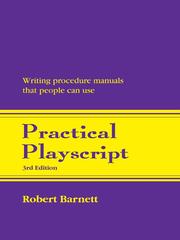| Listing 1 - 10 of 28 | << page >> |
Sort by
|

ISBN: 0958638438 9786611792800 1281792802 1605572349 9781605572345 Year: 2008 Publisher: Belconnen ACT : Robert Barnett & Associates,
Abstract | Keywords | Export | Availability | Bookmark
 Loading...
Loading...Choose an application
- Reference Manager
- EndNote
- RefWorks (Direct export to RefWorks)
"Managing Business Forms," by Robert Barnett, is based on the author's experience in the business forms world for over 40 years. But it is also heavily influenced by the pioneering work of others in the field since the concept of forms management was introduced around the 1940's. We live in a technological world; a world that places a great emphasis on effective management; a world where communication is one of the most talked-about business subjects; a world where business would almost cease to exist if paper didn't exist. Yet we still haven't come to grips with the clerical worker's basic tool of trade-the business form. Of even greater significance is the huge error rate generated by difficult-to-understand forms, bureaucratic language and an almost total lack of understanding of the basis of human communication. Scientific research since the mid-1980's has shown that in excess of 80% of most public-use forms are wrongly filled in resulting in a gigantic cost to business, government and individuals. "Managing Business Forms" aims to address a key component of the problem-the lack of control over forms. Large corporations can have many thousands of different types of forms. Many people look on forms management as just a means of eliminating unnecessary or duplicated forms. There is a belief that all you have to do to get control of forms is to conduct a short-term systems study, cut out the forms that aren't needed, introduce a good stock control system and place an experienced senior clerk in charge. Some organizations even think that all they have to do is outsource their forms stock control to a printing company. "Managing Business Forms" takes the view that if this was all you had to do, forms would not be the problem they are to business and government. The book starts with a brief history of business forms before dealing with major topics such as the structure of a forms management department, indexing and filing of forms, managing new and changed forms, conducting forms reviews, form production and stock control. It also has important chapters for people implementing forms management for the first time covering the planning of a forms management program, getting senior management backing, collecting and cataloguing forms, measuring and reporting savings, and a final chapter on making sure the program works.
Personnel management --- Office procedures. --- Personnel procedure manuals --- Office management
Book
ISBN: 0646251775 1605572330 9781605572338 Year: 2008 Publisher: Canberra, Australia : Robert Barnett and Associates Pty Ltd,
Abstract | Keywords | Export | Availability | Bookmark
 Loading...
Loading...Choose an application
- Reference Manager
- EndNote
- RefWorks (Direct export to RefWorks)
Managing Business Forms,' by Robert Barnett, is based on the author's experience in the business forms world for over 40 years. But it is also heavily influenced by the pioneering work of others in the field since the concept of forms management was introduced around the 1940's. We live in a technological world; a world that places a great emphasis on effective management; a world where communication is one of the most talked-about business subjects; a world where business would almost cease to exist if paper didn't exist. Yet we still haven't come to grips with the clerical worker's basic tool of trade-the business form. Of even greater significance is the huge error rate generated by difficult-to-understand forms, bureaucratic language and an almost total lack of understanding of the basis of human communication. Scientific research since the mid-1980's has shown that in excess of 80% of most public-use forms are wrongly filled in resulting in a gigantic cost to business, government and individuals. "Managing Business Forms" aims to address a key component of the problem-the lack of control over forms. Large corporations can have many thousands of different types of forms. Many people look on forms management as just a means of eliminating unnecessary or duplicated forms. There is a belief that all you have to do to get control of forms is to conduct a short-term systems study, cut out the forms that aren't needed, introduce a good stock control system and place an experienced senior clerk in charge. Some organizations even think that all they have to do is outsource their forms stock control to a printing company. "Managing Business Forms" takes the view that if this was all you had to do, forms would not be the problem they are to business and government. The book starts with a brief history of business forms before dealing with major topics such as the structure of a forms management department, indexing and filing of forms, managing new and changed forms, conducting forms reviews, form production and stock control. It also has important chapters for people implementing forms management for the first time covering the planning of a forms management program, getting senior management backing, collecting and cataloguing forms, measuring and reporting savings, and a final chapter on making sure the program works.
Business records --- Business --- Management. --- Design. --- Business forms --- Trade --- Economics --- Management --- Commerce --- Industrial management
Book
ISBN: 1281792799 9786611792794 1605572322 9781605572321 9780958638425 9781281792792 6611792791 Year: 2005 Publisher: Belconnen, ACT : Robert Barnett and Associates,
Abstract | Keywords | Export | Availability | Bookmark
 Loading...
Loading...Choose an application
- Reference Manager
- EndNote
- RefWorks (Direct export to RefWorks)
'Forms For People,' by Robert Barnett, is a 512 page comprehensive manual on the design and production of business forms. The book has been written for both the experienced forms analyst as well as the novice and part-time form designer and is based on the author's experience in the industry for over 40 years. It covers a wide range of technical subjects such as typography, color, paper selection, offset printing and computer-related forms, with many illustrations and tables for the technically-minded designer. However, it also provides extensive background material based on the author's many years of conducting training courses and workshops in form design. Starting with such basic subjects as "what is a form?" and "the wide variety of forms" it moves on to more advanced subjects such as "human communication", "forms analysis", "usability testing" and "electronic forms." The book's emphasis is on designing forms that people can understand and use rather than just teaching the theory of graphic design and layout. For example, there are five chapters dealing with why people make mistakes when filling out forms and showing what can be done to deal with this using such modern techniques as usability testing. Even when dealing with fundamentals of layout and design, it takes the reader beyond the traditional "upper left corner captioned box" approach and shows how plain language questionnaires can dramatically reduce human error and significantly improve processing productivity. Based on up-to-date scientific research it covers such subjects as "designing forms for aged people" and "how to get people to follow instructions." The final 8 chapters deal with electronic forms, from key issues and implementation through to design and testing. The book finishes with an extensive bibliography of books and papers on forms and related subjects.
Business --- Business records. --- Commercial records --- Corporations --- Office records --- Office management --- Records --- Paperwork (Office practice) --- Business forms --- Business records
Book
ISBN: 9789004433243 9789004433199 Year: 2020 Publisher: Leiden Brill
Abstract | Keywords | Export | Availability | Bookmark
 Loading...
Loading...Choose an application
- Reference Manager
- EndNote
- RefWorks (Direct export to RefWorks)
Conflicting Memories is a study of how the Tibetan encounter with the Chinese state during the Maoist era has been recalled and reimagined by Chinese and Tibetan authors and artists since the late 1970s. Written by an international team of historians, anthropologists, and scholars of religion, literature and film, together with translated extracts from key interviews, biographies, fiction and films, it examines official histories and films, unofficial autobiographies, memoirs and novels as well as oral testimonies and writings by Buddhist adepts. The book explores what these revised versions of the past chose as their focus, which types of people produced them, and what aims they pursued in the production of new, post-Mao descriptions of Tibet under Chinese socialism. Contributors include: Robert Barnett, Benno Weiner, Françoise Robin, Bianca Horlemann, Alice Travers, Alex Raymond, Chung Tsering, Dáša Pejchar Mortensen, Charlene Makley, Xénia de Heering, Nicole Willock, M. Maria Turek, Geoffrey Barstow, Gedun Rabsal, Heather Stoddard, Orgyen Nyima.
Politics and government --- History --- China

ISBN: 128289773X 9786612897733 023151011X Year: 2006 Publisher: New York, NY : Columbia University Press,
Abstract | Keywords | Export | Availability | Bookmark
 Loading...
Loading...Choose an application
- Reference Manager
- EndNote
- RefWorks (Direct export to RefWorks)
There are many Lhasas. One is a grid of uniform boulevards lined with plush hotels, all-night bars, and blue-glass-fronted offices. Another is a warren of alleyways that surround a seventh-century temple built to pin down a supine demoness. A web of Stalinist, rectangular blocks houses the new nomenklatura. Crumbling mansions, once home to noble ministers, famous lovers, nationalist spies, and covert revolutionaries, now serve as shopping malls and faux-antique hotels. Each embodiment of the city partakes of the others' memories, whispered across time and along the city streets.In this imaginative new work, Robert Barnett offers a powerful and lyrical exploration of a city long idealized, disregarded, or misunderstood by outsiders. Looking to its streets and stone, Robert Barnett presents a searching and unforgettable portrait of Lhasa, its history, and its illegibility. His book not only offers itself as a manual for thinking about contemporary Tibet but also questions our ways of thinking about foreign places. Barnett juxtaposes contemporary accounts of Tibet, architectural observations, and descriptions by foreign observers to describe Lhasa and its current status as both an ancient city and a modern Chinese provincial capital. His narrative reveals how historical layering, popular memory, symbolism, and mythology constitute the story of a city. Besides the ancient Buddhist temples and former picnic gardens of the Tibetan capital, Lhasa describes the urban sprawl, the harsh rectangular structures, and the geometric blue-glass tower blocks that speak of the anxieties of successive regimes intent upon improving on the past. In Barnett's excavation of the city's past, the buildings and the city streets, interwoven with his own recollections of unrest and resistance, recount the story of Tibet's complex transition from tradition to modernity and its painful history of foreign encounters and political experiment.
Book
Year: 1941 Publisher: New York Institute of Pacific relations
Abstract | Keywords | Export | Availability | Bookmark
 Loading...
Loading...Choose an application
- Reference Manager
- EndNote
- RefWorks (Direct export to RefWorks)

ISBN: 9780231136808 Year: 2006 Publisher: New York Columbia university press
Abstract | Keywords | Export | Availability | Bookmark
 Loading...
Loading...Choose an application
- Reference Manager
- EndNote
- RefWorks (Direct export to RefWorks)
Book
ISBN: 9780231510110 Year: 2006 Publisher: New York, NY
Abstract | Keywords | Export | Availability | Bookmark
 Loading...
Loading...Choose an application
- Reference Manager
- EndNote
- RefWorks (Direct export to RefWorks)
Book
Year: 1941 Publisher: New York : International Secretariat : Institute of Pacific Relations,
Abstract | Keywords | Export | Availability | Bookmark
 Loading...
Loading...Choose an application
- Reference Manager
- EndNote
- RefWorks (Direct export to RefWorks)
Conditions économiques --- Shanghai (Chine) --- Chine --- Japon --- Relations extérieures --- Conditions économiques
Book
Year: 2022 Publisher: München : Musikproduktion Höflich,
Abstract | Keywords | Export | Availability | Bookmark
 Loading...
Loading...Choose an application
- Reference Manager
- EndNote
- RefWorks (Direct export to RefWorks)
Symfonieën --- Orkest --- Duitsland --- 20e eeuw
| Listing 1 - 10 of 28 | << page >> |
Sort by
|

 Search
Search Feedback
Feedback About
About Help
Help News
News